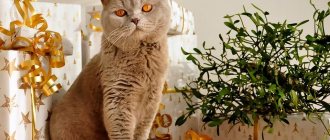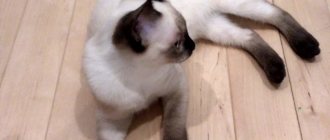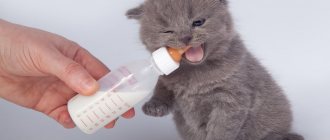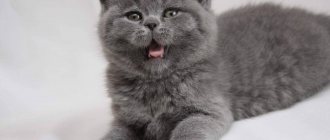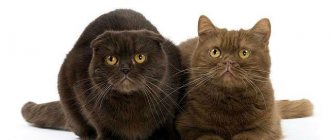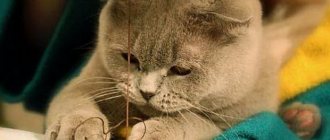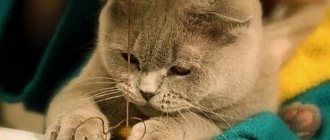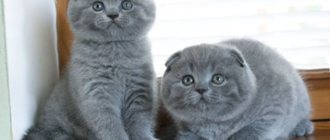“British” and “Scottish” are very often confused, but in fact these animals have many differences. The most obvious of them is the ears. Folding is characteristic exclusively of cats from Scotland, but it does not exclude straight-eared representatives from them. This feature can easily confuse an inexperienced cat lover, and the presence of lop-eared “British” cats in advertisements for the sale of kittens further increases misunderstanding.
If you don’t know how British cats differ from Scottish ones, then don’t rush into buying a pet - study detailed information about both breeds. This will help avoid deception by unscrupulous breeders.
History of the origin of both breeds
Before we figure out how “British” differs from “Scottish,” let’s look at the history of their origin. It will help you understand the reason for the existence of a large number of advertisements for the sale of lop-eared “British dogs”.
British
Due to the antiquity of the breed, it is very difficult to trace the immediate moment of its appearance, but felinologists are inclined to believe that the Roman conquerors were involved. Legionnaires from Rome used cats to catch ship rats that were encroaching on food provisions. Some of the mustachioed hunters moved from their ships to land and settled in Great Britain. As a result of natural crossing with native breeds, a completely new one emerged - the British one.
Street animals gained real popularity only in the second half of the 20th century. As a result of the active interest of breeders, a new variety was obtained - long-haired. She was bred by crossing with Persian cats, but as a result, interbreed matings were banned due to the unevenness of the resulting offspring.
Scottish lop-eared
The English name of the breed is Scottish Fold. These animals appeared as a result of a banal accident. The first owner of floppy ears, named Susie, was born in Scotland in 1961. Her mother was the most ordinary yard cat, and her father remained unknown. Having matured, Susie also gave birth to offspring, but only some of the kittens inherited her droopy ear.
A little later, felinologists found out that the gene responsible for drooping ears is dominant. When two identical genes meet, that is, when two fold-eared pets are mated, their offspring are born sick or die in the womb. For this reason, Scottish Folds can only be mated with Scottish Straights, that is, straight-eared cats.
For a long time, the breed was classified as “British”, allowing interspecific matings. A separate standard for “visloushki” was received only in 1994. For this reason, all lop-eared “British” are just mestizos, not recognized by international felinological organizations.
Scottish Straight
The history of the origin of Scottish straights is similar to Scottish folds. These are the same kittens from Susie who did not receive the lop ear gene. Numerous attempts to artificially preserve the unusual shape of the ears have led to pathologies of the musculoskeletal system.
For this reason, animals began to be bred according to a similar pattern: Scottish Straight + Scottish Fold. In such a combination, only one parent is the carrier of the mutation gene, and the offspring, although motley, are healthy.
Why do breeders not recommend breeding British and Scottish dogs?
British cats are large in size. The gene responsible for their body weight is strong and is inherited. Kittens are born large. The cat’s skeletal system is not able to adapt to large sizes, and childbirth is difficult and with complications.
Mixing breeds causes various diseases that affect the health of the animal:
- Interbreed mix is prone to obesity. Excess weight disrupts the functioning of the urinary system, pyelonephritis and urolithiasis develop.
- Metis suffer from inflammation of the joints , their limbs become deformed, they hurt greatly, and they practically stop moving. This happens because British cats have a powerful body and wide bones, while Scottish cats have weak ligaments.
- Ear diseases are caused by the lop ear gene. It affects the ear cartilage, and your pet often has ear pain. To get rid of pain, the cat constantly scratches them, causing a secondary infection, which leads to inflammation.
External differences between British and Scottish straight cats
The differences between the “British” and the “Scots” lie in their appearance. It's hard not to notice them if you know where exactly to look and don't make a quick assessment based on a first impression.
Body Format
“Englishmen” are characterized by pronounced sexual dimorphism, that is, a significant difference in the sizes of males and females. Cats always look more powerful and muscular, despite the fact that a large and compact body is a breed feature. All representatives of this breed have a wide chest and a massive, but short tail, rounded to the tip.
Another difference between a Scottish cat and a British cat is weight. The maximum weight of the first is no more than 6 kg, and the second is 9 kg. Both types of Scottish have a more slender and slightly elongated body. Thanks to this structure, they look sleeker and lighter. They are also distinguished by a longer and unusually mobile tail, gradually tapering to the tip.
Paws
The difference between the paws of British and Scottish cats is clearly visible. In the former they are short, thick and muscular, while in the latter they are long, slender and graceful.
Head shape
The large round head of the “English” abruptly turns into a wide and muscular neck, which is almost invisible. The “Scots” have a more defined neck, and their small, spherical head resembles an owl’s.
Muzzle, including ears
Thanks to the rougher outlines of the muzzle, the “Englishman” looks serious and businesslike. He has a strong chin, pronounced cheekbones, a wide bridge of the nose, very plump cheeks and wide-set small straight ears, rounded at the tips.
The Scottish nose is narrower and more elongated. Their cheeks and other facial features are smaller, which gives them a more attractive appearance. The resemblance to an owl is added by wide-spaced large round eyes. The shape of the ears depends on the variety, but in both cases they are set closer to the top of the head.
Coat and color
Thanks to their long life on the English streets, the British have a very thick undercoat. Their fur feels like a mouton or soft plush to the touch. The length of the guard hair and the undercoat are the same. The standard allows the following color varieties:
- solid, or one-color;
- tabby;
- color point;
- tortoiseshell;
- silver (chinchilla).
The thickness and softness of the fur coat depends on its color. The most pleasant to the touch are lilac and cream cats, and white cats have the most scanty undercoat.
The Scottish coat is thinner and silkier. Due to its lower density and shorter undercoat, it seems a little loose, but practically does not shed. Any colors are allowed, although the most common are the following:
- particolor;
- tabby;
- silver (chinchilla and shaded);
- van;
- plain.
Unlike the “English”, the long-haired variety of Scottish is recognized only by some felinological organizations. One of the largest is WCF. Such cats are called Highland Straights or Highland Folds depending on the shape of their ears. They are distinguished from their short-haired counterparts by tufts of hair between the toes, a collar and panties.
Does it make sense to pursue a career as a domestic cat?
Both British and Scottish breeds are popular and in demand. Cats with unusual colors are of particular interest. Nowadays, blue and purple colors are most widespread in Russia.
If we are talking about a show-class career, then it depends on the value of your pet as a carrier of the breed’s genes and, possibly, some particularly rare color. The purity of the genetic line is documented upon purchase, and any structural and coloring features can only be determined by an independent expert. In the future, a career is built on participation in exhibitions and prizes that the cat can receive. It is better to get advice from the regional felinological society about the intricacies of breeding and mating.
Differences in the character of British and Scottish cats
Another important difference between British and Scottish cats is their character. The first ones have the following features:
- friendliness and loyalty;
- a calm attitude towards loneliness;
- independence and independence;
- pliability and softness.
The “English” are lenient towards children and other animals, but do not tolerate excessive attention well. Despite this, they always avoid conflict, preferring retreat to fight.
The Scots are much more sociable. They differ:
- playfulness, curiosity and love of travel;
- assertiveness and demandingness;
- intolerance of loneliness;
- devotion and developed sociality.
If there is a lack of attention, Scottish cats will persistently scream, forcing you to play with them and pick them up. They also resort to vocal attacks for the purpose of begging, since they love to eat very much.
How to distinguish a British kitten from a Scottish one
Scottish Folds are born straight-eared. Their ears droop only 3-4 weeks after birth.
Up to 2.5-3 months, “Scots” and “English” are very similar in appearance and character. Playfulness and activity are inherent in most kids, so don’t rush to look for the laziest and calmest ones. Most likely this will be their individual trait, not their breed.
When choosing a very small pet, experienced cat owners recommend the so-called “lice check.” During the meeting, ask the breeder how British cats differ from Scottish ones, and ask for supporting documents for the kittens’ parents. If the answer turns out to be correct and complete, and the pedigree of the parents confirms their thoroughbred, feel free to buy yourself a new pet and be sure to leave a good review for the seller.
cat or cat (loose-eared Scotsman or British)?!
There are no lop-eared British people, so if you want a lop-eared one, it has to be a Scottish one, the British are only straight-eared. The British are less attached to people, independent, they drink, eat and go to bed. Scottish people are more social and love to play. About the cat and the cat. I personally like cats better, they are graceful, better in character, playful, and cats are lazy (especially after castration), they mark the apartment if not neutered, and I also don’t like that cats get fat over time. A cat can be bred once a year, this will not cause any inconvenience, but the kittens can be sold, or sterilized so that the cat has normal hormonal levels.
British*cat
Better than a cat, a cat will give birth constantly, but if you want to breed purebred cats, then you can also have a cat.
The British fold are active for 2-3 years and then very lazy. The breed is aggressive. The cat is angrier.
I have a British cat (not a fold cat, really). Very affectionate, but with character. They are very weak in terms of health, they could not have children, they had surgery. He only eats certain foods and is immediately allergic to others.
Only Scots actually have folds)))
There are NO lop-eared British people!!!
If he has lop ears, then he is 100% Scots, no options. Because there are NO lop-eared British people. British, what kind of floppy ears can there be with such a face?)) )
If you are choosing between a Scottish Fold cat and a male cat, and you are looking for a favorite, I would choose the most affectionate, tame and sociable kitten from the litter, but whether it is a cat or a female cat does not matter)
The British are the British!! ! Only Scots are lop-eared!!! ! I have Scots, two kids are growing up (I’m selling) I fell in love with this breed, about the character, each cat has its own, just like a person. There are some affectionate ones, and some not very affectionate ones. I also brought myself a cat and a male cat as a couple, this time for professional breeding.
A Scot, depending on what for, if you are going to breed kittens, then a girl, maybe a boy, but he will mark everything around. If it’s just for the house, while letting it out into the street, then the boy, the girl will carry the kittens) And if not letting it out, then it’s a girl or a boy, but neutered. In general, you need to take the one you like. You see this one and you immediately want it. take that one
In fact, the British have lop-eared ones.
touch.otvet.mail.ru
Who is better to choose for your home?
Having found out the difference between a “British” and a “Scottish”, let’s summarize which cat to choose for your home. To do this, you will need to analyze your own lifestyle.
Character and temperament
The “English” are phlegmatic and introverted. They are slow, calm and do not need constant communication at all. Such self-sufficient pets are suitable for busy and lonely people without children with a permanent place of residence. They are very attached to their home, so frequent changes of housing can put them under great stress.
Scottish people are more sanguine and extroverted. They love to communicate, are very active and optimistic. Such pets need a large and friendly family, where it is simply impossible to be left alone. Thanks to their curiosity and activity, “Scots” are suitable even for travelers, as they have a positive attitude towards walks on a harness.
